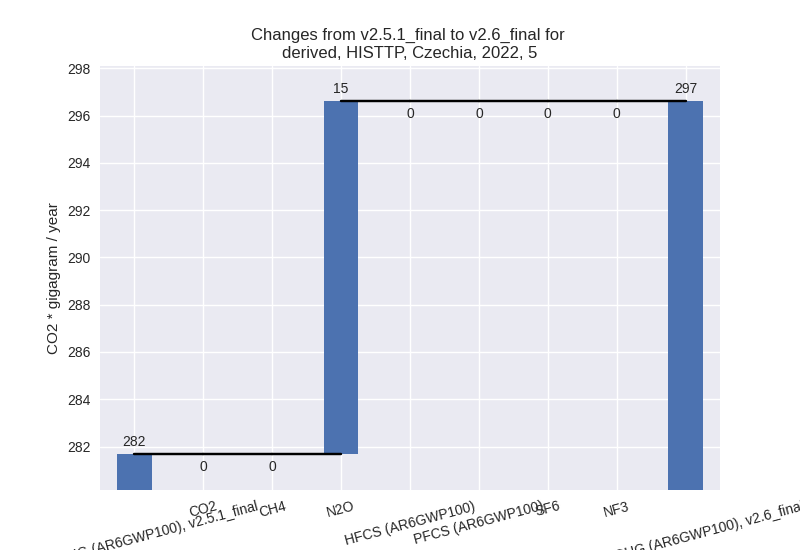Changes in PRIMAP-hist v2.6_final compared to v2.5.1_final for Czechia
2024-09-24
Johannes Gütschow
Change analysis for Czechia for PRIMAP-hist v2.6_final compared to v2.5.1_final
Overview over emissions by sector and gas
The following figures show the aggregate national total emissions excluding LULUCF AR6GWP100 for the country reported priority scenario. The dotted linesshow the v2.5.1_final data.
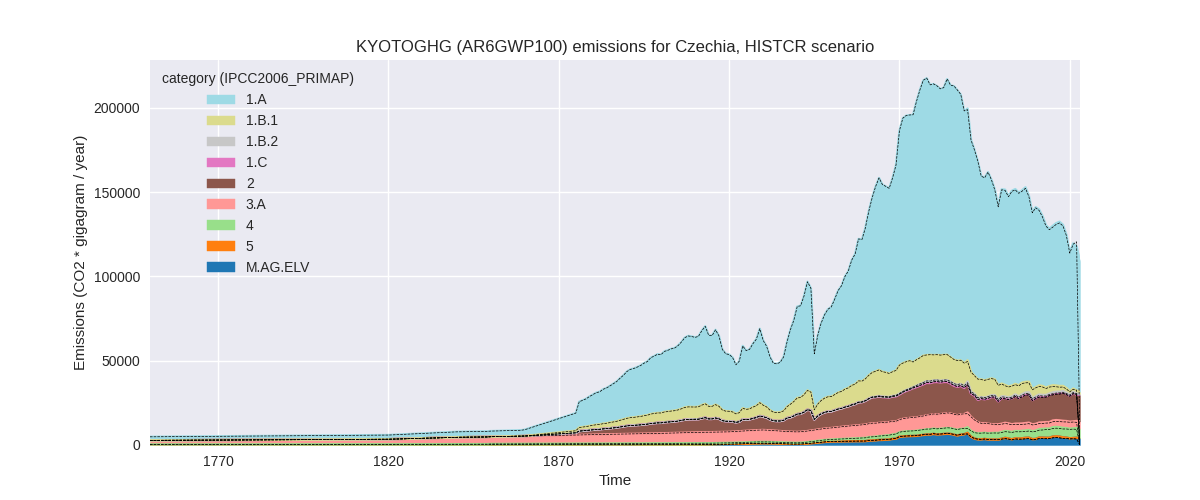
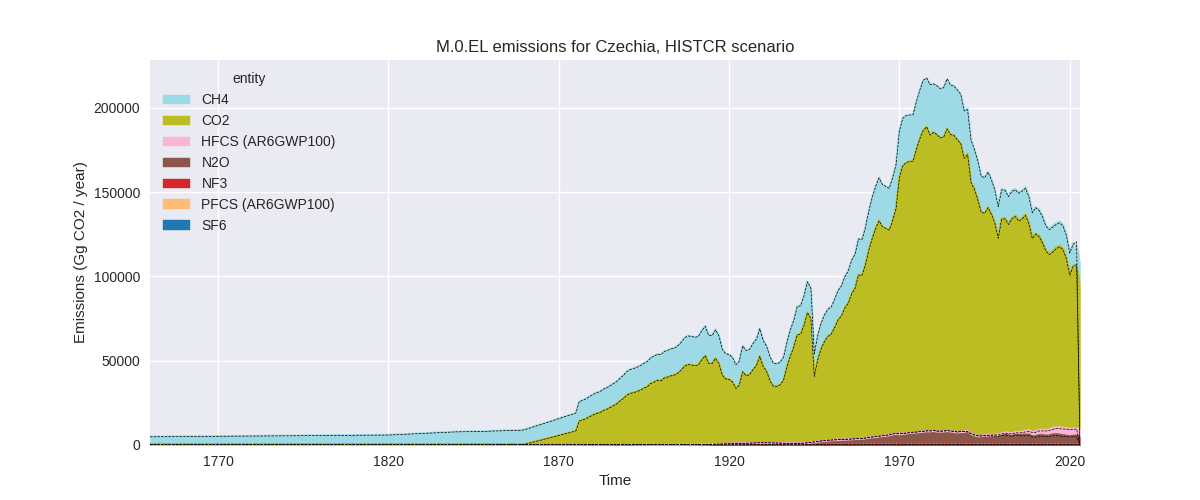
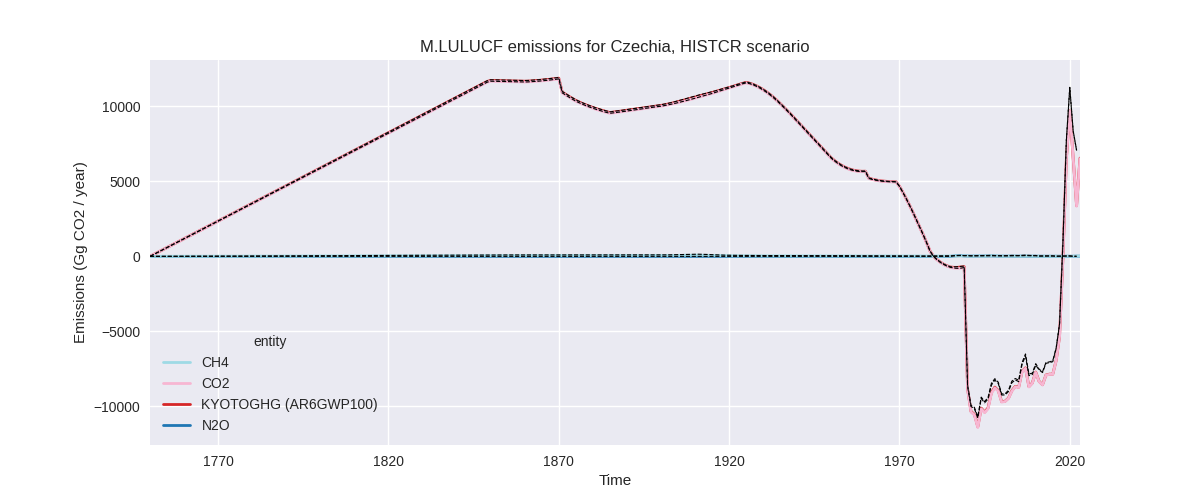
The following figures show the aggregate national total emissions excluding LULUCF AR6GWP100 for the third party priority scenario. The dotted linesshow the v2.5.1_final data.


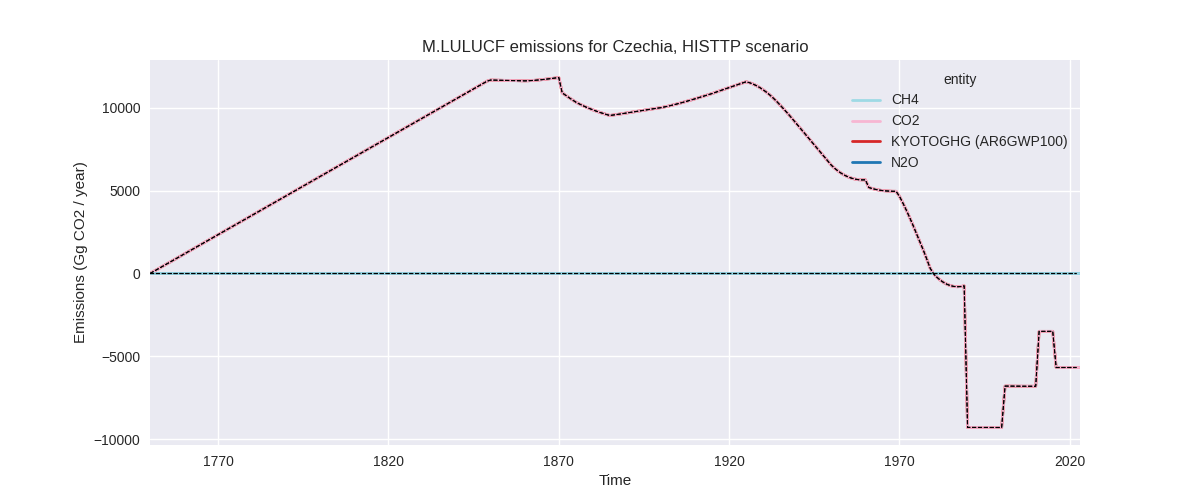
Overview over changes
In the country reported priority scenario we have the following changes for aggregate Kyoto GHG and national total emissions excluding LULUCF (M.0.EL):
- Emissions in 2022 have changed by -2.3%% (-2711.79 Gg CO2 / year)
- Emissions in 1990-2022 have changed by 0.2%% (248.48 Gg CO2 / year)
In the third party priority scenario we have the following changes for aggregate Kyoto GHG and national total emissions excluding LULUCF (M.0.EL):
- Emissions in 2022 have changed by -2.4%% (-2782.35 Gg CO2 / year)
- Emissions in 1990-2022 have changed by -0.0%% (-16.14 Gg CO2 / year)
Most important changes per scenario and time frame
In the country reported priority scenario the following sector-gas combinations have the highest absolute impact on national total KyotoGHG (AR6GWP100) emissions in 2022 (top 5):
- 1: 1.A, CO2 with -2443.09 Gg CO2 / year (-2.8%)
- 2: M.AG.ELV, N2O with 709.80 Gg CO2 / year (21.9%)
- 3: 2, HFCS (AR6GWP100) with -470.41 Gg CO2 / year (-10.0%)
- 4: 2, CO2 with -204.78 Gg CO2 / year (-1.8%)
- 5: 1.B.2, CH4 with -163.16 Gg CO2 / year (-24.2%)
In the country reported priority scenario the following sector-gas combinations have the highest absolute impact on national total KyotoGHG (AR6GWP100) emissions in 1990-2022 (top 5):
- 1: M.AG.ELV, N2O with 358.72 Gg CO2 / year (10.5%)
- 2: 1.A, CO2 with -73.61 Gg CO2 / year (-0.1%)
- 3: 2, HFCS (AR6GWP100) with -20.94 Gg CO2 / year (-1.0%)
- 4: 2, CO2 with -12.49 Gg CO2 / year (-0.1%)
- 5: 1.B.1, CH4 with -6.05 Gg CO2 / year (-0.1%)
In the third party priority scenario the following sector-gas combinations have the highest absolute impact on national total KyotoGHG (AR6GWP100) emissions in 2022 (top 5):
- 1: 1.A, CO2 with -2947.98 Gg CO2 / year (-3.3%)
- 2: 4, CH4 with 604.40 Gg CO2 / year (11.7%)
- 3: 2, HFCS (AR6GWP100) with -348.41 Gg CO2 / year (-7.8%)
- 4: 2, CO2 with -111.17 Gg CO2 / year (-3.0%)
- 5: 4, CO2 with -24.02 Gg CO2 / year (-27.1%)
In the third party priority scenario the following sector-gas combinations have the highest absolute impact on national total KyotoGHG (AR6GWP100) emissions in 1990-2022 (top 5):
- 1: 1.A, CO2 with -91.71 Gg CO2 / year (-0.1%)
- 2: 4, CH4 with 73.66 Gg CO2 / year (1.5%)
- 3: 4, N2O with 22.15 Gg CO2 / year (11.9%)
- 4: 4, CO2 with -13.52 Gg CO2 / year (-20.5%)
- 5: 2, HFCS (AR6GWP100) with -10.56 Gg CO2 / year (-0.6%)
Notes on data changes
Here we list notes explaining important emissions changes for the country. ’' means that the following text only applies to the TP time series, while means that it only applies to the CR scenario. Otherwise the note applies to both scenarios.
- We have added EEA 2024 inventory data.
- Lower energy CO2 is due to lower emissions estimates in EEA2024 (CR) and EI2024 (TP)
- N2O from agriculture without livestock is higher in 2022 and cumulatively because EEA2024 emissions are higher than CRF2023 (CR)
- 2022 HFC emissions are lower because EEA2024 shows declining emissions for 2022 in contrast to the longer term trend (CR).
- Changes in sector 4 are due to the removal of FAOSTAT data (TP).
Changes by sector and gas
For each scenario and time frame the changes are displayed for all individual sectors and all individual gases. In the sector plot we use aggregate Kyoto GHGs in AR6GWP100. In the gas plot we usenational total emissions without LULUCF. ## country reported scenario
2022


1990-2022
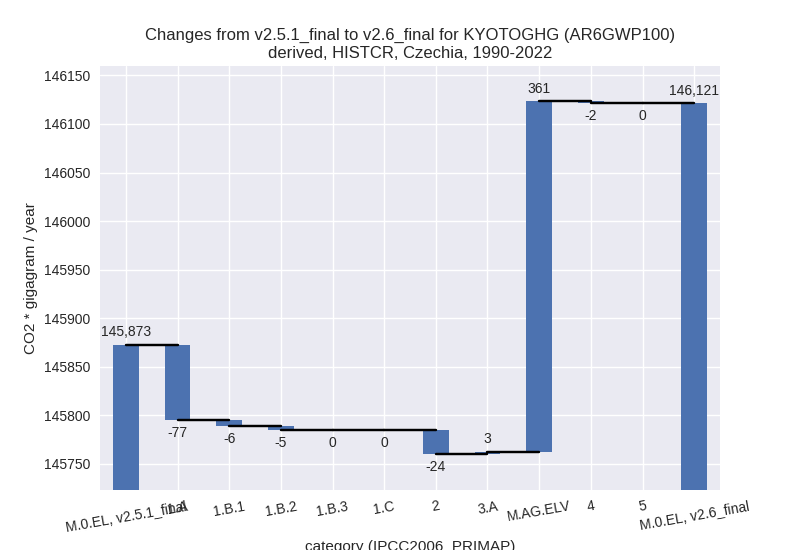
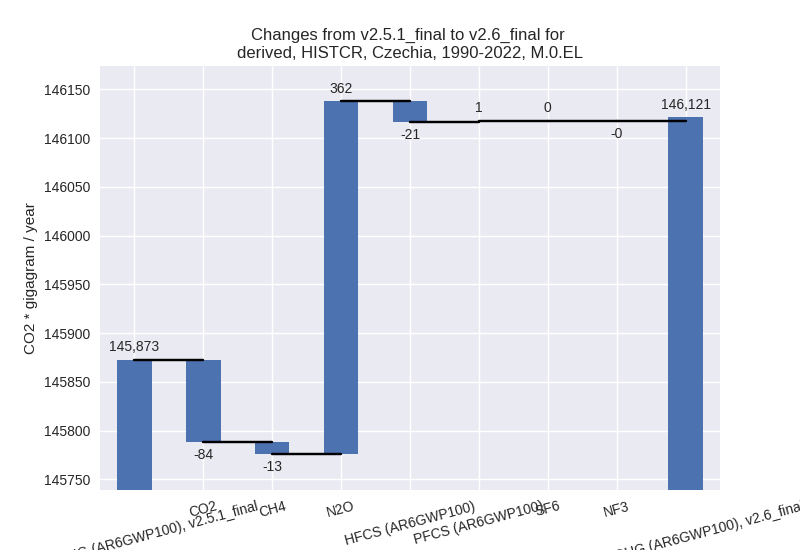
third party scenario
2022
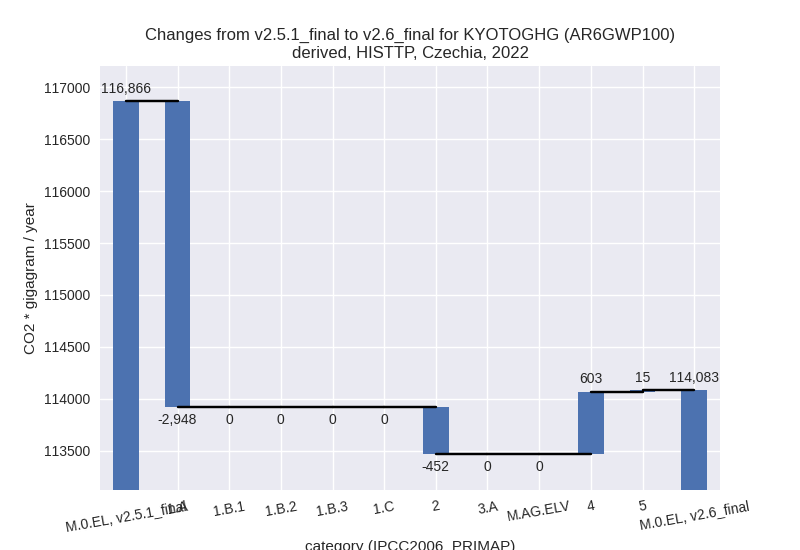
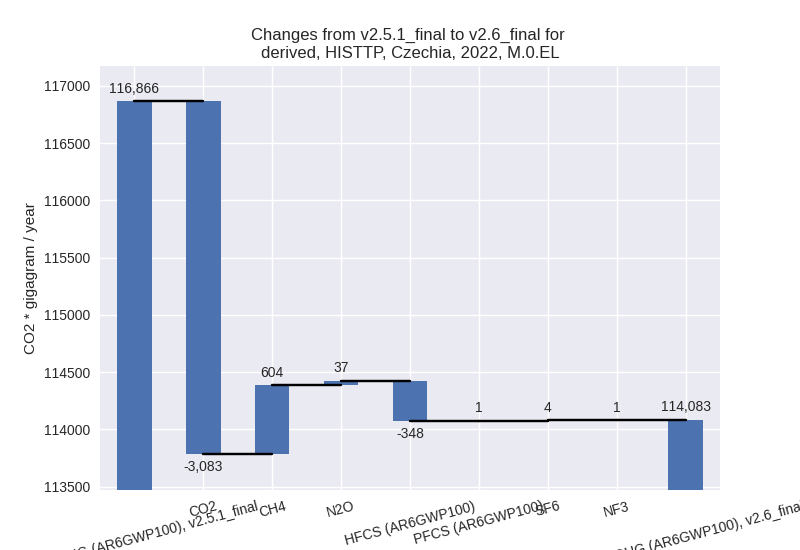
1990-2022
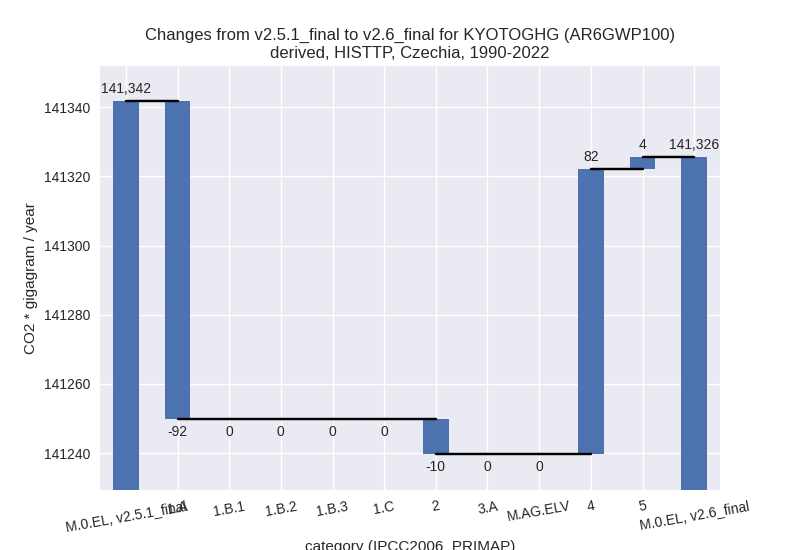
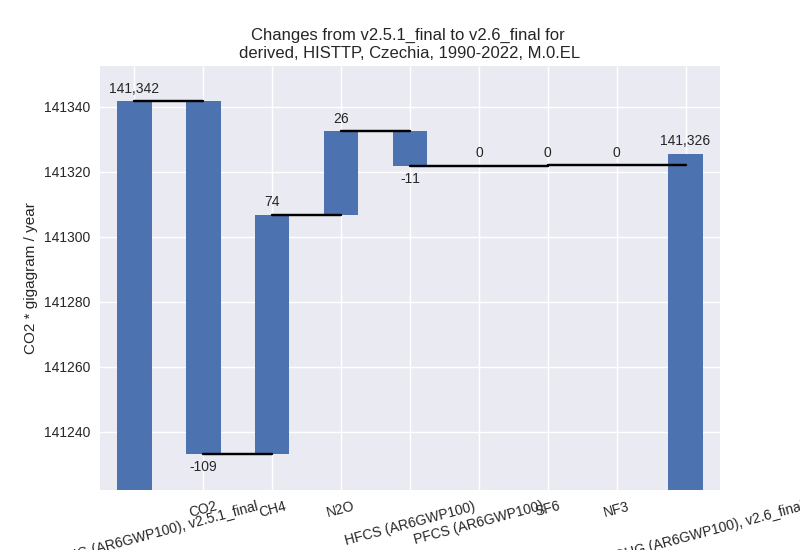
Detailed changes for the scenarios:
country reported scenario (HISTCR):
Most important changes per time frame
For 2022 the following sector-gas combinations have the highest absolute impact on national total KyotoGHG (AR6GWP100) emissions in 2022 (top 5):
- 1: 1.A, CO2 with -2443.09 Gg CO2 / year (-2.8%)
- 2: M.AG.ELV, N2O with 709.80 Gg CO2 / year (21.9%)
- 3: 2, HFCS (AR6GWP100) with -470.41 Gg CO2 / year (-10.0%)
- 4: 2, CO2 with -204.78 Gg CO2 / year (-1.8%)
- 5: 1.B.2, CH4 with -163.16 Gg CO2 / year (-24.2%)
For 1990-2022 the following sector-gas combinations have the highest absolute impact on national total KyotoGHG (AR6GWP100) emissions in 1990-2022 (top 5):
- 1: M.AG.ELV, N2O with 358.72 Gg CO2 / year (10.5%)
- 2: 1.A, CO2 with -73.61 Gg CO2 / year (-0.1%)
- 3: 2, HFCS (AR6GWP100) with -20.94 Gg CO2 / year (-1.0%)
- 4: 2, CO2 with -12.49 Gg CO2 / year (-0.1%)
- 5: 1.B.1, CH4 with -6.05 Gg CO2 / year (-0.1%)
Changes in the main sectors for aggregate KyotoGHG (AR6GWP100) are
- 1: Total sectoral emissions in 2022 are 87911.39 Gg
CO2 / year which is 74.6% of M.0.EL emissions. 2022 Emissions have
changed by -3.2% (-2862.05 Gg CO2 /
year). 1990-2022 Emissions have changed by -0.1% (-88.40 Gg CO2 / year). For 2022 the
changes per gas
are:
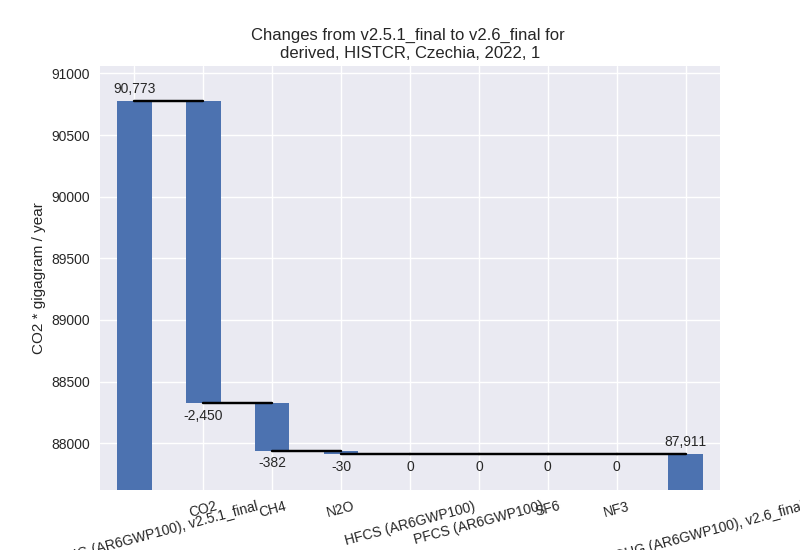
The changes come from the following subsectors:- 1.A: Total sectoral emissions in 2022 are 85475.81
Gg CO2 / year which is 97.2% of category 1 emissions. 2022 Emissions
have changed by -2.9% (-2536.05 Gg
CO2 / year). 1990-2022 Emissions have changed by -0.1% (-77.21 Gg CO2 / year). For 2022 the
changes per gas
are:
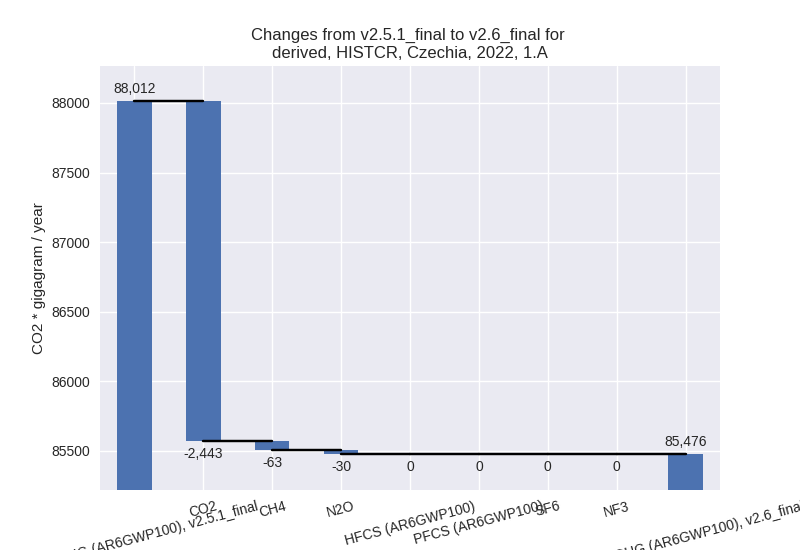
There is no subsector information available in PRIMAP-hist. - 1.B.1: Total sectoral emissions in 2022 are 1920.43
Gg CO2 / year which is 2.2% of category 1 emissions. 2022 Emissions have
changed by -7.8% (-162.76 Gg CO2 /
year). 1990-2022 Emissions have changed by -0.1% (-6.24 Gg CO2 / year). For 2022 the
changes per gas
are:
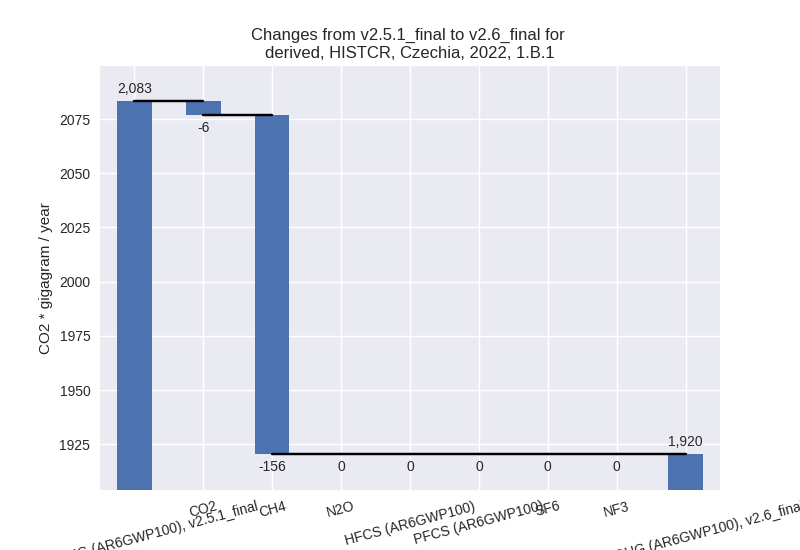
There is no subsector information available in PRIMAP-hist. - 1.B.2: Total sectoral emissions in 2022 are 515.15
Gg CO2 / year which is 0.6% of category 1 emissions. 2022 Emissions have
changed by -24.1% (-163.25 Gg CO2 /
year). 1990-2022 Emissions have changed by -0.6% (-4.95 Gg CO2 / year). For 2022 the
changes per gas
are:
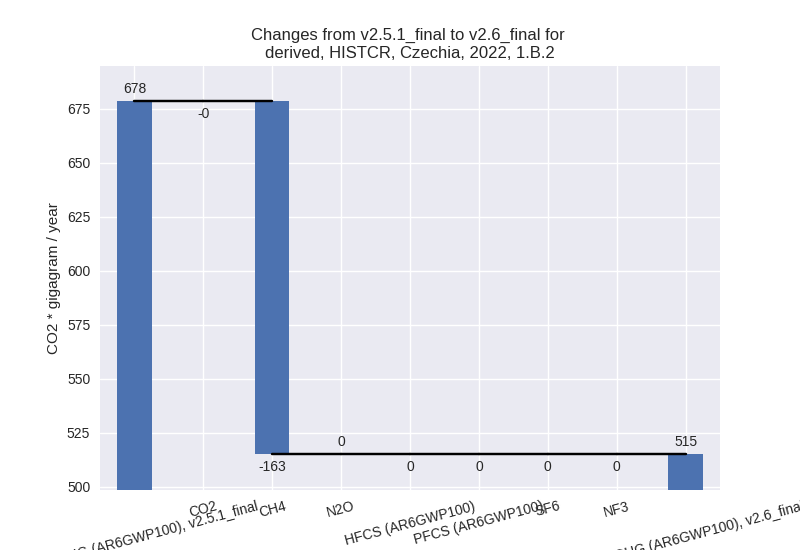
There is no subsector information available in PRIMAP-hist.
- 1.A: Total sectoral emissions in 2022 are 85475.81
Gg CO2 / year which is 97.2% of category 1 emissions. 2022 Emissions
have changed by -2.9% (-2536.05 Gg
CO2 / year). 1990-2022 Emissions have changed by -0.1% (-77.21 Gg CO2 / year). For 2022 the
changes per gas
are:
- 2: Total sectoral emissions in 2022 are 15678.29 Gg
CO2 / year which is 13.3% of M.0.EL emissions. 2022 Emissions have
changed by -3.9% (-636.13 Gg CO2 /
year). 1990-2022 Emissions have changed by -0.2% (-24.45 Gg CO2 / year). For 2022 the
changes per gas
are:

- M.AG: Total sectoral emissions in 2022 are 8529.17
Gg CO2 / year which is 7.2% of M.0.EL emissions. 2022 Emissions have
changed by 11.1% (849.56 Gg CO2 /
year). 1990-2022 Emissions have changed by 4.2% (363.25 Gg CO2 / year). For 2022 the
changes per gas
are:
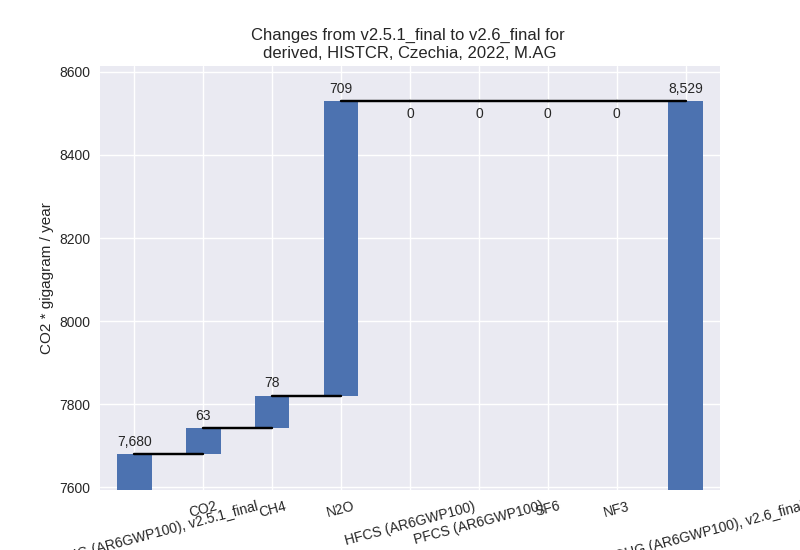
For 1990-2022 the changes per gas are: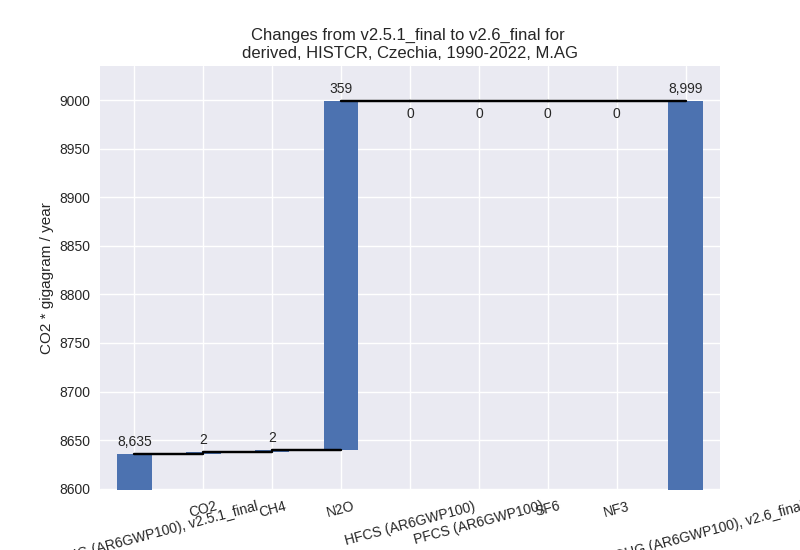
The changes come from the following subsectors:- 3.A: Total sectoral emissions in 2022 are 4238.31 Gg CO2 / year which is 49.7% of category M.AG emissions. 2022 Emissions have changed by 1.9% (77.02 Gg CO2 / year). 1990-2022 Emissions have changed by 0.1% (2.63 Gg CO2 / year).
- M.AG.ELV: Total sectoral emissions in 2022 are
4290.86 Gg CO2 / year which is 50.3% of category M.AG emissions. 2022
Emissions have changed by 22.0%
(772.53 Gg CO2 / year). 1990-2022 Emissions have changed by 9.7% (360.62 Gg CO2 / year). For 2022 the
changes per gas
are:

For 1990-2022 the changes per gas are: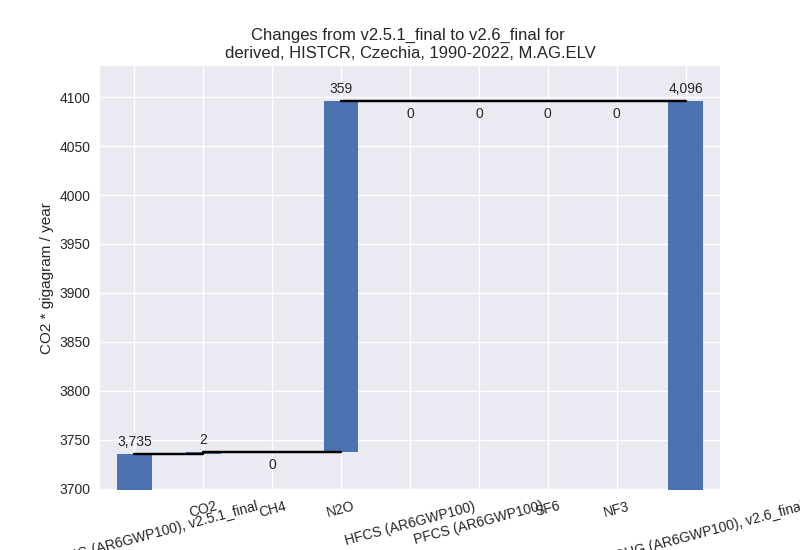
There is no subsector information available in PRIMAP-hist.
- 4: Total sectoral emissions in 2022 are 5690.32 Gg CO2 / year which is 4.8% of M.0.EL emissions. 2022 Emissions have changed by -1.1% (-63.17 Gg CO2 / year). 1990-2022 Emissions have changed by -0.0% (-1.91 Gg CO2 / year).
- 5: No data
third party scenario (HISTTP):
Most important changes per time frame
For 2022 the following sector-gas combinations have the highest absolute impact on national total KyotoGHG (AR6GWP100) emissions in 2022 (top 5):
- 1: 1.A, CO2 with -2947.98 Gg CO2 / year (-3.3%)
- 2: 4, CH4 with 604.40 Gg CO2 / year (11.7%)
- 3: 2, HFCS (AR6GWP100) with -348.41 Gg CO2 / year (-7.8%)
- 4: 2, CO2 with -111.17 Gg CO2 / year (-3.0%)
- 5: 4, CO2 with -24.02 Gg CO2 / year (-27.1%)
For 1990-2022 the following sector-gas combinations have the highest absolute impact on national total KyotoGHG (AR6GWP100) emissions in 1990-2022 (top 5):
- 1: 1.A, CO2 with -91.71 Gg CO2 / year (-0.1%)
- 2: 4, CH4 with 73.66 Gg CO2 / year (1.5%)
- 3: 4, N2O with 22.15 Gg CO2 / year (11.9%)
- 4: 4, CO2 with -13.52 Gg CO2 / year (-20.5%)
- 5: 2, HFCS (AR6GWP100) with -10.56 Gg CO2 / year (-0.6%)
Changes in the main sectors for aggregate KyotoGHG (AR6GWP100) are
- 1: Total sectoral emissions in 2022 are 92553.59 Gg
CO2 / year which is 81.1% of M.0.EL emissions. 2022 Emissions have
changed by -3.1% (-2947.98 Gg CO2 /
year). 1990-2022 Emissions have changed by -0.1% (-91.71 Gg CO2 / year). For 2022 the
changes per gas
are:

The changes come from the following subsectors:- 1.A: Total sectoral emissions in 2022 are 89134.73
Gg CO2 / year which is 96.3% of category 1 emissions. 2022 Emissions
have changed by -3.2% (-2947.98 Gg
CO2 / year). 1990-2022 Emissions have changed by -0.1% (-91.71 Gg CO2 / year). For 2022 the
changes per gas
are:
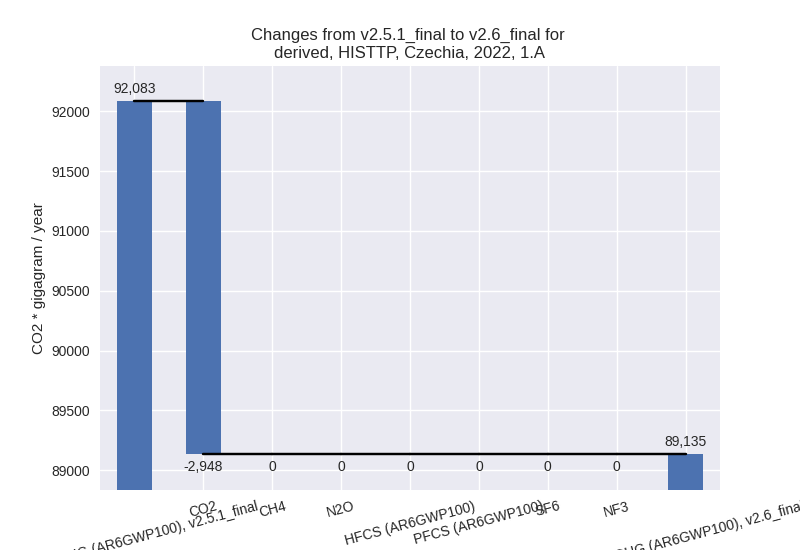
There is no subsector information available in PRIMAP-hist. - 1.B.1: Total sectoral emissions in 2022 are 2453.29 Gg CO2 / year which is 2.7% of category 1 emissions. 2022 Emissions have changed by 0.0% (0.00 Gg CO2 / year). 1990-2022 Emissions have changed by 0.0% (0.00 Gg CO2 / year).
- 1.B.2: Total sectoral emissions in 2022 are 965.57 Gg CO2 / year which is 1.0% of category 1 emissions. 2022 Emissions have changed by 0.0% (0.00 Gg CO2 / year). 1990-2022 Emissions have changed by 0.0% (0.00 Gg CO2 / year).
- 1.A: Total sectoral emissions in 2022 are 89134.73
Gg CO2 / year which is 96.3% of category 1 emissions. 2022 Emissions
have changed by -3.2% (-2947.98 Gg
CO2 / year). 1990-2022 Emissions have changed by -0.1% (-91.71 Gg CO2 / year). For 2022 the
changes per gas
are:
- 2: Total sectoral emissions in 2022 are 8779.85 Gg
CO2 / year which is 7.7% of M.0.EL emissions. 2022 Emissions have
changed by -4.9% (-452.26 Gg CO2 /
year). 1990-2022 Emissions have changed by -0.1% (-10.24 Gg CO2 / year). For 2022 the
changes per gas
are:
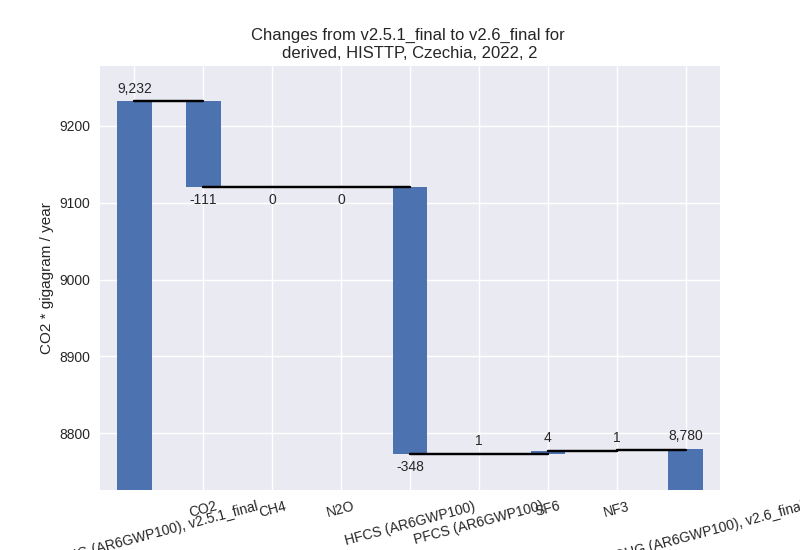
- M.AG: Total sectoral emissions in 2022 are 6347.62 Gg CO2 / year which is 5.6% of M.0.EL emissions. 2022 Emissions have changed by 0.0% (0.00 Gg CO2 / year). 1990-2022 Emissions have changed by 0.0% (0.00 Gg CO2 / year).
- 4: Total sectoral emissions in 2022 are 6105.48 Gg
CO2 / year which is 5.4% of M.0.EL emissions. 2022 Emissions have
changed by 11.0% (602.95 Gg CO2 /
year). 1990-2022 Emissions have changed by 1.6% (82.30 Gg CO2 / year). For 2022 the
changes per gas
are:
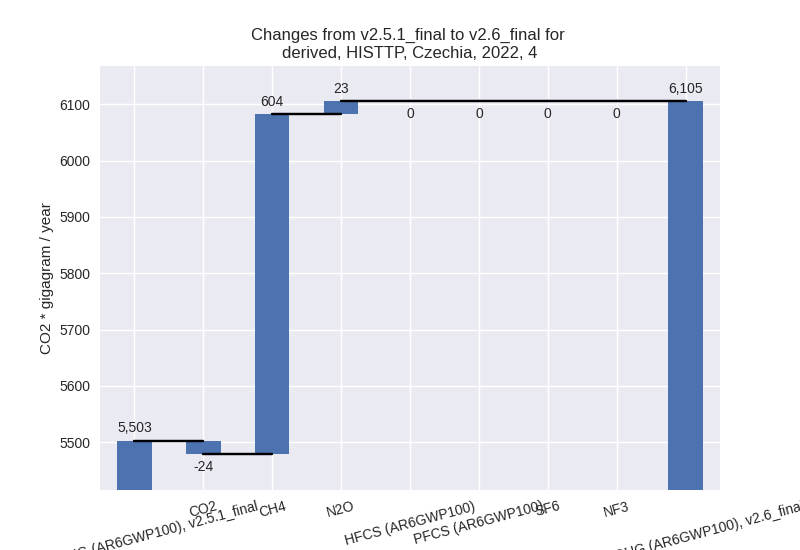
- 5: Total sectoral emissions in 2022 are 296.60 Gg
CO2 / year which is 0.3% of M.0.EL emissions. 2022 Emissions have
changed by 5.3% (14.93 Gg CO2 /
year). 1990-2022 Emissions have changed by 0.8% (3.52 Gg CO2 / year). For 2022 the
changes per gas
are:
